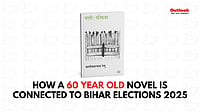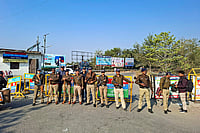Normally, healthy kidneys filter blood quietly—about half a cup every minute, adding up to thousands of litres each week. But when they begin to fail, life undergoes a profound shift, bringing patients face-to-face with the silent epidemic of chronic kidney disease (CKD).
Of these more than 2.2 lakh Indians develop end-stage kidney disease (ESRD) annually—the final phase of chronic kidney failure when organs cannot filter waste from blood. For those affected, the rhythms of daily life—work, travel, meals, finances, and even family routines—begin to orbit around a single life-sustaining procedure: dialysis.
Yet, amid this gruelling regimen, one element remains remarkably undiminished: hope. A hope that assures these ESRD patients that all is not lost, and that in this arduous journey, they do not walk alone.
Their stories of challenges, hope and survival echoed through at AarogyaDeep Utsav 2025, an event organised in the national capital last week by the DCDC Kidney Care. The patients who have completed 5, 10, 15 and even 20 years on dialysis were felicitated with much fanfare. The message was uplifting: You Are Not Alone.
On the occasion, Dr. Shobha Vijender, Founding President of Sampurna and Member of the Delhi Commission for Women lauded the resilience of the patients amid tough medical conditions. “With endurance and the right support system, patients can not only live longer—they can live with dignity, ambition, and meaningful purpose.”
Doctors call CKD a “silent killer” because the disease often goes unnoticed until 90% of kidney function is lost. Diabetes and hypertension—rising rapidly across India—remain the leading causes. Misuse of painkillers is also to be blamed for rising kidney ailments.
“When kidneys fail, only two options remain—dialysis or a transplant. And with transplants so scarce, dialysis becomes the default,” said Dr Vikram Kalra, Additional Director of Nephrology and Renal Transplant at Aakash Healthcare Super Speciality Hospital, Delhi.
“Yes, there is still a shortage of dialysis centres. Officially, India records around 2 lakh new patients requiring dialysis every year, and the actual numbers may be even higher. This rising burden makes it essential for people to adopt preventive measures—maintaining a healthy lifestyle, controlling blood sugar and blood pressure, eating a low-salt diet, exercising regularly, and avoiding obesity.”
These steps can significantly reduce the risk of chronic kidney disease and renal failure. In this context, prevention remains far better than cure, said Dr. Kalra. He advised patients on dialysis to ensure good-quality treatment, maintain regular follow-ups, and follow a doctor-guided diet for better outcomes.
An EY–NATHEALTH report warns the country needs at least 65,000 dialysis centres and 20,000 more trained staff including nephrologists to meet demand.
The gap is daunting: Limited financial assistance, shortage of human resources and absence of facilities at Tier-2 and Tier-3 cities as well as in the rural regions.
The State Governments, organisations and private–public partnerships are stepping in to reach out to the needy. Aseem Garg, founder of DCDC which runs both PPP and standalone centres in 13 States in the country said, “Our patients are in their prime years. We want them to remain productive, so we’ve introduced home and nocturnal dialysis as well. Patients should not be made to travel far.”
Job continuity is essential for mental well-being. Patients should not quit work, he stressed.
Take the case of Abhishek, 31, who moved from Gorakhpur to Delhi for better treatment. Since travel is difficult, he has built a career in digital marketing—working from home while managing his health, he told The Health Outlook.
He shared the realities of the strict diet dialysis patients follow. “I measure water in millilitres—never more than 600 a day. Soups, juices, even fruit… everything counts,” he said.
What he wants most is empathy. “We need doctors to explain why each medicine is given. A CKD patient goes through more than the reports show.”
For 41-year-old Sanjay Singh, dialysis has been a companion for nine years. His younger brother, 36, is also on dialysis. “It’s expensive, especially medicines,” he said. “Ayushman should cover it fully.” Yet he is grateful: “We’re alive because this treatment exists.”
Garg believes more can be done.
“Just as citizens above 70 are automatically covered under Ayushman Bharat, all dialysis patients should be brought under the scheme,” he said. “We have fewer than ten lakh dialysis patients—this is manageable.”
He added that patients who receive regular dialysis often return to work and contribute to the economy.
“They remain productive members of society. Universal coverage for dialysis would make a huge difference.” Beyond financial support, Garg stressed on the need for emotional and psychological care.
“The mental burden is enormous. Counselling for patients and caregivers is as important as the treatment itself.”
Awareness is urgently needed about how to prevent the diseases as well as compliance once you get the ESRD. Dr. Deepak Agarwal, Physician and Vice President, Clinical Excellence DCDC Kidney Care said while clinical guidance demands three sessions per week — roughly 12 hours in total — compliance remains low.
“In our data, only 40% follow the prescribed thrice-weekly schedule. Around 60% skip sessions, most often during summer.” Missed sessions often result in ICU admissions, he warned.
“Acceptance is crucial,” said the doctors. “The first two to three years are difficult. But those who adjust their lifestyle, eat less salt or salty foods, avoid phosphate rich food and consume more high protein meals and get family support go on to live long, productive lives.”
Take the case of 45-year-old Mamta Sharma from Dakshinpuri who is taking three sessions a week. “My children take tuition to help,” the widow said quietly. “They want me to live. That keeps me strong.”
Santosh Shukla (51) who arrived at the event with his son Varun, a young software engineer, said he has been through several hospitals—Pandav Nagar, Janakpuri, Hauz Khas—before settling at Rajiv Gandhi Super Speciality Hospital at Tahirpur, Delhi. Travel exhausts him, and diet restrictions shape every meal. But Varun’s unwavering support makes each day easier. “His presence gives me confidence,” Santosh said.
At the event, young patients like Abhishek summed up the concerns, echoing the demands of those undergoing treatment.
“Patients are seeking affordable and uninterrupted dialysis, supported by an expanded healthcare infrastructure that can meet the growing need," they said, emphasizing the importance of adequately trained manpower to ensure quality care.
Alongside this, they also stressed on robust insurance support to ease financial burdens, and for the system to provide empathetic, patient-centered medical care that respects their challenges and dignity.








.png?auto=format%2Ccompress&fit=max&format=webp&w=768&dpr=1.0)

















